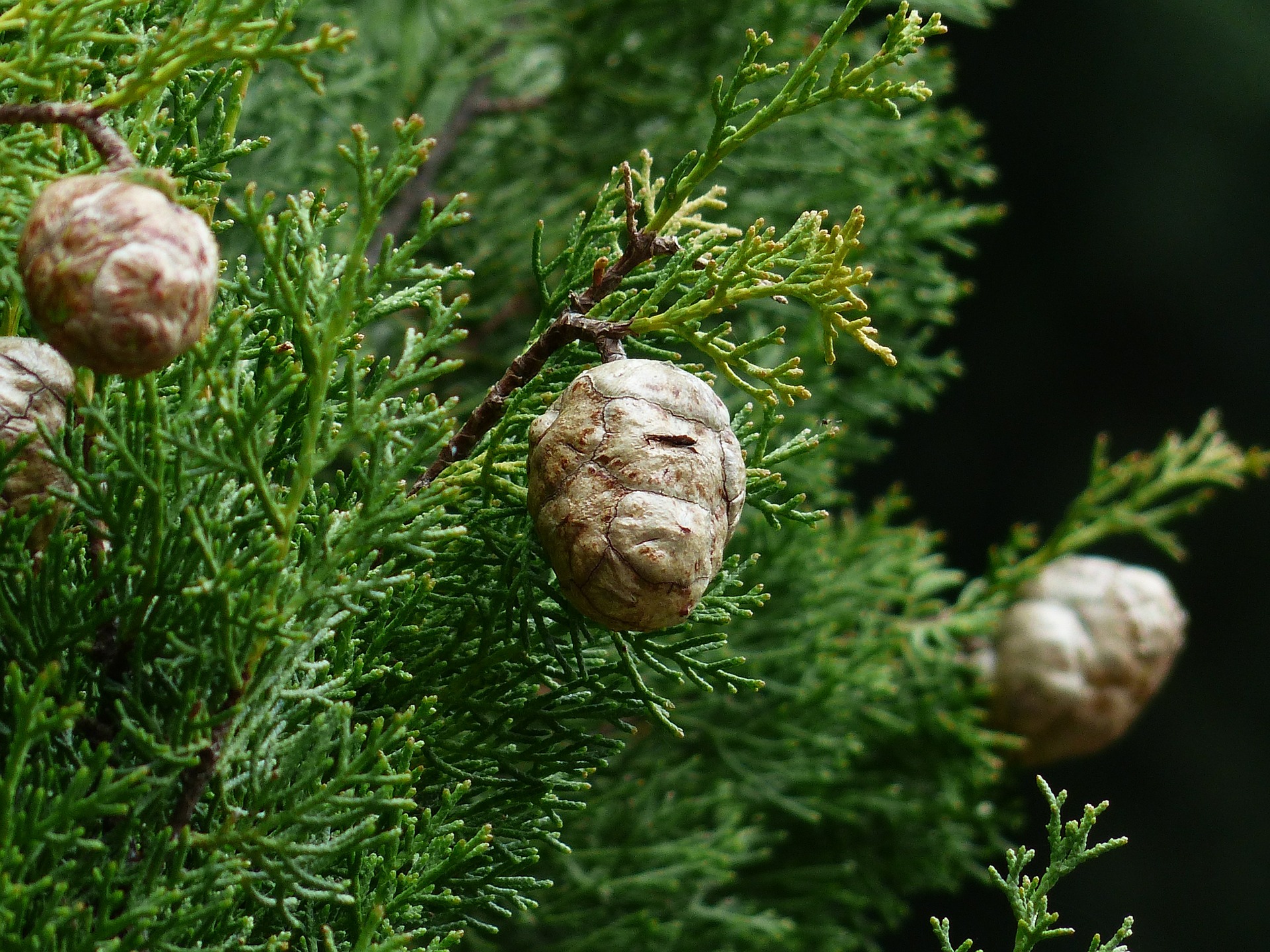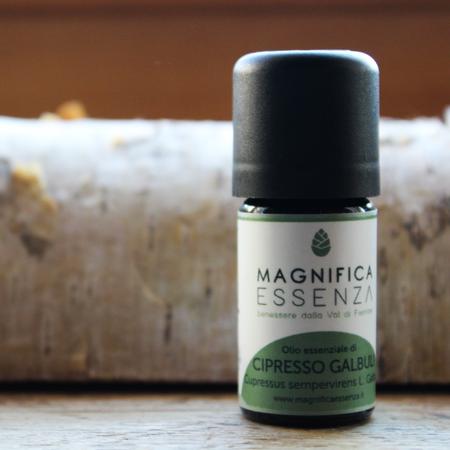An in-depth study from a scientific point of view on the essential oil of cypress, to understand its properties and its uses.
Cypress: how to recognized it
The cypress is an evergreen tree, which can reach a height of up to 30 m, native to Greece and Crete, but present throughout the Mediterranean (in particular Italy, France, Spain, Morocco), which is part of the order of the Cupressaceae. According to the ancients, the etymology of this last term refers to the Semitic word kyros, that is Cyprus, where the tree abounds. This would support the idea that the cypress is one of the oldest known medicinal plants.

The cypress is a conical, resinous tree with resinous ducts / canals in the phloem and xylem inducible, almost always monoecious, more rarely dioecious, with multi-year scaly leaves, unisexual, simple, scaly flowers, staminate cones (pollen producers) ; most also carry ovulated (seed producing) cones. Galbuli are pseudo-fruits with tightly pressed woody scales that enclose the seeds.

Cypress essential oil: characteristics
For the production of Cypress essential oil (scientifically known as Cupressus sempervirens L. var.stricta Aiton) the parts that can be used:
- the twigs,
- rarely the cones (or “galbuli”),
- more rarely wood.
Here Cypress essential oil features:
- Extraction method: steam distillation, with an average distillation time ranging from 2 to 5 hours. Yield 0.5-1% twigs; 0.2-1% galbuli.
- Color: colorless to pale yellow. Spicy smell, reminiscent of juniper and pine.
- Main constituents: Fruits: 0.5% essential oil: α-pinene (> 55%), delta-carene (> 30%), cedrol; proanthocyanidols; diterpenic acids; tannins. Twigs: bislavones; 0.3-0.8% essential oil (monoterpenic, sesquiterpene, diterpene hydrocarbons).
Essential oil: our tip
Here is the Cypress essential oil that Erboristeria Como has selected for you, pure, sure of its high quality (and personally distilled by Prof. Valussi):

This pure essential oil of cypress, scientific name Cupressus sempervirens L. Galbuli, is product for distillation of galbuli (fruits) from spontaneus plants in Veneto, with altitude 500 meters above sea level, and It has for brand Gadoi- Magnifica Essenza, in Val di Fiemme (Trentino).
Few distil this precious essential oil (galbuli cypress essential oil). Unlike the other essential oils of conifers, the essential oil of cypress galbuli has warmer and woody notes that derive from the high resin content inside the fruits (cleaning the distiller is very hard!).
The essential oil of cypress: properties
For P. Shelley, aromatherapist and author of the “Treatise on Aromatherapy”, the main characteristics common to the essential oils obtained from Cupressaceae (eg cypress, juniper), of the order of the Conifers, are the remarkable general hygienic properties, especially for the air and skin. Cypress essential oil , in particular, is also effective in urinary tract infections and diseases of the circulatory system and scalp (Rouviere and Meyer 1983). It has a truly remarkable astringent action, much higher than that of hazelnut oil (Durraffourd).
From inferences related to the content in chemical compounds and from generalizations from clinical cases, it can be stated that the essential oil of Cypress is:
- antiseptic;
- deodorant (perspiration of the feet);
- decongestant, mucolytic and expectorant;
- antibacterial;
- antiperspirant (excessive perspiration);
- anti-infective (bronchitis, flu);
- astringent (rupture of capillaries) and vasoconstrictor (thanks to proanthocyanidols, which inhibit the angiotensin I conversion enzyme in vitro);
- calming (regulates the sympathetic nervous system, irritability);
- draining (edema, rheumatic swelling),
- phlebotonic (poor venous circulation, protecting the circulation at the capillary level),
- neurotonic (asthenia).
Campanini, in her “Dictionary of Phytotherapy and Medicinal Plants” indicates that cypress is useful for varicose veins, phlebitis, menopause vascular disorders, hemorrhoids, spasmodic cough. Cones, he explains, are traditionally used in the treatment of subjective manifestations of venous insufficiency, in hemorrhoidal symptoms and in menopause disorders.
How to use
We recommend using cypress essential oil:
- in topical applications: as a rubefacient for muscle cramps, poor circulation, rheumatic pain for oily and acne-prone skins (among other things we find cypress in the form of an extract in many products of the Sebolift line of our eco bio cosmeceuticals), poorly perfused skins, superficial wounds. In ointments use it at 5-10%;
- used as inhalations or ambient fragrance for tiredness, stress, nervousness, lack of concentration Always by inhalation, for laryngitis and pharyngitis, sinusitis, asthma, bronchitis, spasmodic cough, whooping cough;
- for safety, even if the essential oil is for aromatherapy, we do not recommend its internal use (because the FDA has not yet approved this use for this essential oil).
For example, for anxiety, the combination of Cypress essential oil with essential oil of lemon, officinal lavender, geranium is useful for Shelley, while for irritability the combination of Cypress essential oil with oil is useful. essential of frankincense, officinal lavender, geranium, and / or bergamot.
Cypress essential oil is useful for hydrolipidic retention, that is cellulite, as well as lemon and officinal lavender essential oil.
Essential oil: reports
Cypress essential oil is neither irritating nor sensitizing.
Possible Adulterations: cypress essential oils are often coarsely cut with mixtures of Δ3-hulls and pinenes. Deca-2- (E), 4- (Z) -dienyl isovalerate is used to reinforce the odor of “elongated” cypress OE, and small amounts of deca-2- (E), 4- (Z) – dienyl isovalerate to bring the smell back to normal, otherwise too coarse.
For any clarification or for more information Contact us.
Follow us on our Facebook and Instagram channels
ALL RIGHT ARE RESERVED, THIS TEXT IS NOT REPRODUCIBLE WITHOUT EXPRESS AUTHORIZATION OF ERBORISTERIA COMO

